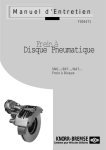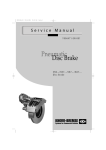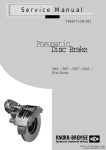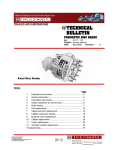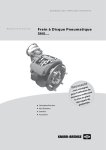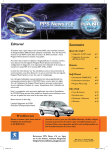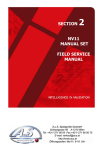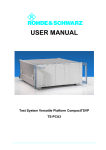Download BENDIX BW2000 User's Manual
Transcript
SD-23-7550 ® AIR DISC BRAKE (SB-6™ and SB-7™) SUPPLY PORT ACTUATOR ROD RETURN SPRINGS OUTER BRAKE PAD ROTOR LEVER ACTUATING BEAM ECCENTRIC BEARING INNER BRAKE PAD AXIAL RADIAL FIGURE 1 - BENDIX AIR DISC BRAKE 1 Index Page 1 1.1 1.2 1.2.1 1.3 1.4 1.4.1 1.5 Exploded view of brake Axial Disc Brake Components Axial Disc Brake Repair Kits Axial Disc Brake Wear Indicator Kits Radial Disc Brake Components Radial Disc Brake Repair Kits Radial Disc Brake Wear Indicator Kits Brake Disc Rotor 4 5 5 6 7 7 8 2 2.1 2.2 2.3 2.4 General information (for “Axial- and Radial Disc Brake”) Service Tools Diagnostic Equipment Lubrication Torque requirements 9 9 9 9 3 3.1 3.2 3.2.1 3.2.2 3.2.3 3.3 3.4 3.4.1 3.4.2 3.4.3 Description and Function Axial Disc Brake Sectioned View Description of operation Brake actuation Brake release Brake adjustment (automatic) Radial Disc Brake Sectioned View Description of operation Brake actuation Brake release Brake adjustment (automatic) 10 11 11 11 11 12 13 13 13 13 4 Safety instructions for service work (for “Axial- and Radial Disc Brake”) 5 Brake Testing (for “Axial- and Radial Disc Brake”) Troubleshooting procedure Adjuster check Wear limits of Brake Pads and Rotor Brake wear check using Guide Pin (for Calipers with standard Guide Pins) Brake wear check using Guide Pin (for Calipers with long Guide Pins) Wear Indicators Diagnostic-Equipment - Hand held device ZB9031 Diagnostic-Equipment - Vehicle mounted device ZB9033 14 15 16 18 19 20 21 21 Pad replacement (for “Axial- and Radial Disc Brake”) Pad removal Tappet Boot check Caliper floatation check Pad fitting 22 22 23 23 Tappet with Boot replacement (for “Axial- and Radial Disc Brake”) Tappet with Boot removal Adjuster thread inspection Tappet with Boot fitting 24 25 25 5.1 5.2 5.3 5.3.1 5.3.2 5.3.3 5.4 5.5 6 6.1 6.1.1 6.1.2 6.2 7 7.1 7.1.1 7.2 8 2 Caliper Suspension Sealing (for “Axial- and Radial Disc Brake”) 13 27 9 9.1 9.2 10 10.1 10.2 10.2.1 10.2.2 Guide Pin Bushing replacement (for “Axial- and Radial Disc Brake”) Brass Bushing replacement Rubber Bushing replacement 28 28 28 Caliper replacement (for “Axial- and Radial Disc Brake”) Caliper removal Caliper fitting Caliper with Rubber Boot (10) Caliper with Steel Cap (10a) 29 30 30 31 11 Carrier replacement (for “Axial- and Radial Disc Brake”) 32 12 12.1 12.2 12.3 12.4 Actuation cylinder replacement (for “Axial- and Radial Disc Brake”) Brake Chamber removal Brake Chamber fitting Spring Brake removal Spring Brake fitting 33 33 34 34 13 13.1 13.2 13.3 13.4 Additional Information Service Video Service Tool Kit Diagnostic Equipment General Safety Guidelines 35 35 35 36 Personal Notes 3 1 Exploded views 1.1 Axial Disc Brake Components (for Wear Indicatators Kits see 1.2.1) 44 26 11 45 12 18/1 18/2 Assembly grease (coloured) 1 6*) 13 37 4 39 7 161 5 9 40 31 4 Caliper Carrier Sleeve Sleeve Rubber Bushing Brass Bushing Inner Boot Outer Boot Steel Cap Pad Retainer Pad Tappet with Boot Spring Brake Assembly grease (white) 10 31a *) ) 10a * 1 2 4 5 6 7 9 10 10a 11 12 13 18/1 58 18/2 26 31 31a 37 39 40 44 45 58 161 Brake Chamber Spring Clip Outer Boot Clip O-Ring Adjuster Cap Caliper Bolt Caliper Bolt Pad Retainer Pin Washer Ring Tappet Bushing 2 VF 00127/12-ÄiO1 *) possible variants by items 10a & 31a 1.2 Axial Disc Brake Repair Kits CAUTION Use only Genuine Bendix® parts The following Repair Kits are available Description Carrier Guide Kit Carrier Guide Kit (Steel Cap) Wear Indicator Kit (per axle) Guide Pins Kit Guide Pins Kit (Steel Cap) Seal Kit for Guide Pins Tappet and Boot Kit (2 pcs) Pad Set (per axle) Adjuster Cap (4 pcs) Pad Retainer Kit (per axle) Pad Retainer Kit (per axle) wear sensor Kit for Floating Pin Outer Guide Seal Kit (10 pcs) Kit for Fixed Pin Kit for Steel Cap Screw Kit for Steel Cap Screw Kit for Outer Boot Contents Association of Repair Kits to the Disc Brakes and Repair Kit’s Order no. 2, 4, 5, 31, 39, 40 2, 4, 5, 10a, 31a, 39, 40 for variants see 1.2.1 with or without 104 4-7, 9, 10, 31, 39, 40, 58 4, 5, 6, 7, 9, 10a, 31a, 39, 40, 58 9, 10, 31, 37, 58 13, 161 12, 26, 37, 44, 45 37 11, 26, 44, 45 11, 26, 44, 45, 104, 115, 116 4, 6, 39 10, 31 5, 7, 9, 10a, 31a, 40, 58 10a, 31a 10a, 31a, 39, 40 10, 31, 39, 40 Exchange Caliper r.h. only in assembled condition Exchange Caliper l.h. see www.Bendix.com for more information http://www.Bendix.com see Type plate on the Caliper 1.2.1 Axial Disc Brake Wear Indicator Kits (Typical kits are shown below) Type 1 Type 4 Type 2 Type 5 Type 3 101 102 104 112 Sensor 115 Sensor 116 Cable Protection Plate 117 Clip 119 120 Spring Washer Screw Wear Indicator Cable Bracket Bracket 5 1.3 Radial Disc Brake Components (for Wear Indicator Kits see 1.4.1) 1 2 4 5 6 7 9 10 10a 11 12 13 18/1 18/2 6 Caliper Carrier Sleeve Sleeve Rubber Bushing Brass Bushing Inner Boot Outer Boot Steel Cap Pad Retainer Pad Tappet with Boot Spring Brake Brake Chamber 26 31 31a 37 39 40 44 45 58 161 Spring Clip Outer Boot Clip O-Ring Adjuster Cap Caliper Bolt Caliper Bolt Pad Retainer Pin Washer Ring Tappet Bushing *) possible variants by items 10a & 31a 1.4 Radial Disc Brake Repair Kits CAUTION: Use only Geniune Bendix parts The following Repair Kits are available Description Carrier Guide Kit Carrier Guide Kit (Steel Cap) Wear Indicator Kit (per axle) Guide Pins Kit Guide Pins Kit (Steel Cap) Seal Kit for Guide Pins Tappet and Boot Kit (2 pcs) Pad Set (per axle) Adjuster Cap (4 pcs) Pad Retainer Kit (per axle) Pad Retainer Kit (per axle) wear sensor Kit for Rubber Sleeve Outer Guide Seal Kit (10 pcs) Repair Kit Kit for Steel Cap Screw Kit for Steel Cap Screw Kit for Outer Boot Contents Association of Repair Kits to the Disc Brakes and Repair Kit’s Order no. 2, 4, 5, 31, 39, 40 2, 4, 5, 10a, 31a, 39, 40 for variants see 1.2.1 with or without 104 4-7, 9, 10, 31, 39, 40, 58 4, 5, 6, 7, 9, 10a, 31a, 39, 40, 58 9, 10, 31, 37, 58 13, 161 12, 26, 37, 44, 45 37 11, 26, 44, 45 11, 26, 44, 45, 104, 115, 116 4, 6, 39 10, 31 5, 7, 9, 10a, 31a, 40, 58 10a, 31a 10a, 31a, 39, 40 10, 31, 39, 40 Exchange Caliper r.h. only in assembled condition Exchange Caliper l.h. see www.Bendix.com for more information http://www.Bendix.com see Type plate on the Caliper 1.4.1 Radial Disc Brake Wear Indicator Kits (Typical kits are shown below) Type 1 Type 4 Type 2 Type 5 Type 3 101 102 104 112 Sensor 115 Sensor 116 Cable Protection Plate 117 Clip 119 120 Spring Washer Screw Wear Indicator Cable Bracket Bracket 7 1.5 Brake Rotors (for “Axial- and Radial Disc Brake”) When replacing the Rotors, please also refer to the instructions provided by the Vehicle Manufacturer. They should also referred to when spec'ing Bendix Rotors. When replacing Rotors, please adhere to the recommended bolt tightening torques. The use of non-approved Brake Rotors will reduce levels of safety and invalidate warranty. Brake Rotors can be ordered through any authorized Bendix parts outlet. More information can be found on the internet at www.Bendix.com This information booklet is also available electronically when you visit www.Bendix.com. 8 2 General Information (for “Axial- and Radial Disc Brake”) 2.1 Service Tools Part Number Description ll 19252 Press-In Tool for Tappet and Boot (13) ll 19253 Pull-In Tool for Inner Boot (9) ll 19254 II 32202 Pull-In/Out Tool for Brass Bushing (7) Wedged Fork for removal of Tappet and Boot (13) II 36797 Grooving Tool for Brass Bushing (7) Z001105 Press in Tool for Steel Cap (10a) Service tool kit ZB 9032 II 37951/004EX contains the tools listed as well as this Service manual. The service video is available separately as Part No. KBP2060/1, in the UK, and elsewhere as RA-SB0002 EN. 2.2 Diagnostic Equipment Part Number Description ll 36695 ZB 9031 Hand held device for checking Potentiometer function. ( Also Pad + Disc wear when 13 pin chassis plug installed ). ll 38691F ZB 9033 Chassis mounted device for measuring Pad + Disc wear 2.3 Lubrication 2) Part Number Description Colour Application ll 14525 Renolit HLT2 White 2) Brass Bushing (7) II 32793 Syntheso GL EP1 Green 2) Rubber Bushing (6) Important Note: The correct Grease MUST be used for each Bushing! 2.4 Torque requirements Item Number 39 + 40 Torque Ft. lbs. [Nm] Caliper Bolts M16x1.5 - 10.9 Actuator Mounting Nuts M16x1.5 210±18 [285 spanner size in. (mm) ±25 132+22 [180 ] +30 ] 0.55 (14) 0.94 (24) 9 3 3.1 Description and function Axial Disc Brake Sectioned View 31a*) 161 9 5 7 40 10a*) 31 12 10 16 23 26 45 1 2 4 5 6 7 9 10 10a 11 12 13 16 17 18/1 18/2 19 20 22 23 24 26 27 28 30 31 31a 32 33 37 39 40 44 45 46 161 10 Caliper Carrier Sleeve Sleeve Rubber Bushing Brass Bushing Inner Boot Outer Boot Steelcap Pad Retainer Pad Tappet with Boot Threaded Tube Bridge Spring Brake Brake Chamber Lever Eccentric Bearing Inner Seal Cap Adjuster Unit Turning Device Spring Clip Spring Spring Chain Outer Boot Clip O-Ring Chain Wheel Wear Sensor Adjuster Cap Caliper Bolt Caliper Bolt Pad Retainer Pin Washer Rotor Tappet Bush 37 30 11 32 33 43 44 24 1 161 2 13 22 4 39 6 18/1 18/2 12 46 12 17 19 27 28 20 VF 00127/2-Äi01 *) possible variants by items 10a & 31a 3.2 Description of operation (Floating Caliper principle) 3.2.1 Brake actuation During actuation, the Push Rod of the Actuator (18/1 or 18/2) moves the Lever (19). The input forces are transferred via the Eccentric Bearing (20) to the Bridge (17). The force is then distributed by the Bridge (17) and the two Threaded Tubes (16) to the Tappets (13) and finally to the inboard Pad (12). After overcoming the running clearance between the Pads and the Rotor, the reaction forces are transmitted to the outboard Pad (12). The clamping forces on the Pads (12) and the Rotor (46) generate the braking force for the wheel. 3.2.2. Brake release After releasing the air pressure, the two Return Springs (27/28) push the Bridge (17) and Lever (19) back to the start position; this ensures a running clearance between Pads and Disc is maintained. 3.2.3 Brake adjustment (automatic) To ensure a constant running clearance between Disc and Pads, the brake is equipped with a low wearing, automatic adjuster mechanism. The Adjuster (23) operates with every cycle of actuation due to the mechanical connection with Lever (19). As the Pads and Disc wear, the running clearance increases. The Adjuster (23) and Turning Device (24) turn the Threaded Tubes (16) by an amount necessary to compensate for this wear. The total running clearance (sum of clearance both sides of Disc) should be between 0.03 and 0.04 in. (0.6 and 0.9 mm.; smaller clearances may lead to overheating problems. 11 3.3 Radial Disc Brake Sectioned View 31a*) 9 10 31 7 5 40 161 10a*) 16 24 22 33 44 32 26 45 11 30 17 37 1 2 4 5 6 7 9 10 10a 11 12 13 16 17 18/1 18/2 19 20 22 23 24 26 27 28 30 31 31a 32 33 37 39 40 44 45 46 161 12 Caliper Carrier Sleeve Sleeve Rubber Bushing Brass Bushing Inner Boot Outer Boot Steelcap Pad Retainer Pad Tappet with Boot Threaded Tube Bridge Spring Brake Brake Chamber Lever Eccentric Bearing Inner Seal Cap Adjuster Unit Turning Device Spring Clip Spring Spring Chain Outer Boot Clip O-Ring Chain Wheel Wear Sensor Adjuster Cap Caliper Bolt Caliper Bolt Pad Retainer Pin Washer Rotor Tappet Bushing 43 23 1 VF 00113/3-Äi01 13 39 4 6 2 12 27; 28 20 19 18/1; 18/2 46 VF 00113/4 *) possible variants by items 10a & 31a 3.4 Description of operation (Floating Caliper principle) 4 Safety Instructions for service work 3.4.1. Please refer to the relevant safety instructions for repair work on commercial vehicles, especially for jacking up and securing the vehicle. Brake Actuation During actuation, the Push Rod of the Actuator (18/1 or 18/2) moves the Lever (19). The input forces are transferred via the Eccentric Bearing (20) to the Bridge (17). The force is then distributed by the Bridge (17) and the two Threaded Tubes (16) to the Tappets (13) and finally to the inboard Pad (12). After overcoming the running clearance between the Pads and Rotor, the reaction forces are transmitted to the outboard Pad (12). The clamping forces on the Pads (12) and the Rotor (46) generate the braking force for the wheel. 3.4.2. Brake release After releasing the air pressure, the two Return Springs (27/28) push the Bridge (17) and Lever (19) back to the start position; this ensures a running clearance between Pads and Rotor is maintained. 3.4.3 Brake adjustment (automatic) To ensure a constant running clearance between Rotor and Pads, the brake is equipped with a low wearing, automatic adjuster mechanism. The Adjuster (23) operates with every cycle of actuation due to the mechanical connection with Lever (19). As the Pads and Rotor wear, the running clearance increases. The Adjuster (23) and Turning Device (24) turn the Threaded Tubes (16) by an amount necessary to compensate for this wear. The total running clearance (sum of clearance both sides of Rotor) should be between 0.03 and 0.04 in. (0.6 and 0.9 mm.; smaller clearances may lead to overheating problems. (for “Axial- and Radial Disc Brake”) Use only Genuine Bendix parts. WARNING! Before starting repair work, block the wheels to ensure that the vehicle cannot roll away, before releasing the park brake. See Page 36 for full Safety Guidelines. Please follow repair manual instructions and adhere to the wear limits of the Pads and the Rotors - see Section 5.3. Use only recommended tools - see Section 2.1. Tighten bolts and nuts to the recommended torque values - see Section 2.4. After re-fitting the wheel according to the Vehicle Manufacturer’s recommendations, please ensure that there is sufficient clearance between the Tire Valve Stem, the Caliper and the wheel rim, to avoid damage to the Valve. After service work: Check the brake performance and the system behavior by actual road test. 13 5 Brake Testing (for Axial- and Radial Disc Brake) 5.1 Fault finding procedure Air Disc Brake Lift vehicle, turn wheel by hand Does wheel turn smoothly? NO Residual pressure within the braking cylinder? NO Running clearance ok? (see section 5.2) NO YES YES Running clearance ok? (see section 5.2) Yes NO Check and if necessary, change or service preceding braking device Check adjuster (see section 5.2) YES Brake pad wear uneven? (see note below) END NO END YES END Check and if necessary, maintain caliper guide pins Adjuster ok? NO YES (see section 9) END Caliper guidance ok? (see section 6.1.2) NO Change caliper YES (see section 10) Tightness not due to disc brake END END Check and if necessary, maintain caliper guide pins (see section 9) END Note: Difference between inboard and outboard pad less than 0.2in.(< 5mm), and diagonal wear ≤ 0.08in (2 mm) 14 FD00102EN-Äi01 5.2 Adjuster check WARNING! Before starting repair work, block the wheels to ensure that the vehicle cannot roll away, before releasing the park brake. See Page 36 for full Safety Guidelines. 23 37 Remove wheel. The caliper assemply should be pushed inboard on its guide pins. Using a suitable tool, press the inboard pad (12) away from the Tappets and check Tappet and inboard pad backplate - it should be between 0.02in. (0.5mm) & 0.04in. (1.0mm). If the running clearance is too small or large, the adjuster may not be functioning correctly and should be checked as follows. M+P-KN-039 Remove Cap (37). 23 CAUTION! Do not overload or damage the Adjuster (23). Use only 8mm Box End Wrench or 1/4Ó" drive Socket with a lever length no greater than 4in. (100mm). DO NOT use an Open Ended Wench since this may damage the Adjuster shaft. 37 1 M+P-KN-015 The Adjuster should be turned counter-clockwise for 2 or 3 clicks (increasing running clearance). CAUTION! Make sure that the Box End Wrench or Socket can turn freely while completing the following procedures. By applying the brake 5 - 10 times (about 30psi, or 2 Bar) the Box End Wrench or Socket should turn clockwise in small increments if the Adjuster is functioning correctly (see notes below). M+P-KN-043 If Pads are not being changed, Cap (37) should be replaced having lightly greased it with Renolit HLT2 (available as part number II14525). NOTE: As the number of applications increases, incremental adjustment will decrease. NOTE: If the Box End Wrench or Socket does not turn, turns only with the first application or turns forward and backward with every application, the automatic Adjuster has failed and the Caliper must be replaced. 15 5.3 Wear Limits of Pads and Rotors CAUTION! Stay within the Rotor and Pad Wear Limits Pads The thickness of the Pads must be checked regularly dependent on the usage of the vehicle. The Pads should be checked to adhere to any applicable legal requirements that may apply. If no Wear Indicator has been connected, check for wear at least every 3 months. If friction material is less than 0.08in. (2mm) (see E), the Pads must be replaced. C A B Rotors Measure thickness at the thinnest point. Avoid measuring near the edge of the disc as a burr may be present. A = Rotor thickness (new condition) 1.77in. (45mm) B = Rotor thickness (worn) 1.46in. (37 mm), Disc must be replaced C = Overall thickness of Pad (new) 1.18in. (30mm) D = Backplate 0.35in. (9mm) E = Minimum thickness of friction material 0.08in. (2mm) F = Minimum allowed thickness in worn condition for backplate and friction material 0.43in. (11mm) (replacement of Pads necessary). E D F M+P-KN-002 If wear dimension B ≤ 1.53in. (39 mm) Rotor should be replaced together with Pads. Wear dimension B = 1.46in. (37 mm) must not decrease. Minimum allowable thickness B=1.46in. (37 mm) CAUTION! These recommendations must be followed for proper brake performance. 16 A1 a At each change of Pads check the Rotors for grooves and cracks. The diagram at the right shows possible conditions of the surface. A1 = Small cracks spread over the surface are allowed B1 max. 0.75 x a max. 1.5 mm B1 = Cracks less than 0.06in. (1.5mm) deep or wide, running in a Radial direction, are allowed C1 = Grooves (circumferencial) less than 0.06in. (1.5mm) wide are allowed D1 C1 D1 = Cracks in the vanes are not allowed and the Rotor MUST BE REPLACED. a = Pad contact area Note In case of surface conditions A1,-C1, the Rotor can remain in service until it has reached the minimum thickness of 1.46in. (37 mm) is reached. VF 00127/3 Knorr-Bremse Rotor are normally service-free and refinishing, when changing Rotors, is not necessary. However, refinishing could be useful, e.g. to increase the load-bearing surface of the Pads, after severe grooving on the entire friction surface has occurred. To meet safety requirements, the minimum thickness after refinishing is > 1.53in. (39 mm). In addition, follow the recommendations provided by the Vehicle Manufacturer. CAUTION! Follow these recommendations. Excessive Pad or Disc wear will degrade optimum performance. 17 5.3.1 Brake Wear Check using Guide Pin (For all Axial and Radial Disc Brakes except those listed in Section 5.3.2 - These Callipers do not have the rib in position B (see also Section 5.3.2) 1 4 1 4 6 6 C B D M+P-KN-005 Pad conditions can be visually inspected without removing the road wheel by noting the positon of the Floating Pin (4) in the Caliper (1). If dimension ‘C’ is less than 0.04in. (1mm), a more accurate check of the Pads and Disc must be completed. If necessary change the Pads - see Section 6 18 B = without rib (see also Section 5.3.2) C = pin protrusion - shown in new condition D = minimal pin protrusion - Pads and Rotor must be checked with road wheel removed 5.3.2 Brake Wear Check using Guide Pin (Only for Axial Disc Brakes SB 7541, SB 7551 to SB 7629, SB 7639 and Radial Disc Brakes SB 7102, SB 7112, SB 7103, SB 7113, SB 7104, SB 7114, SB 7105, SB 7115, SB 7108, SB7118, SB 7109, SB 7119, SB 7120, SB 7130 - These Callipers do have the rib in position B (see also Section 5.3.1) 1 1 4 6 4 6 B C D Pad conditions can be visually inspected without removing the road wheel by noting the positon of the Floating Pin (4) in the Caliper (1). M+P-KN-006 B = with rib (see also Section 5.3.1) C = new condition D = 0.64in. (18mm) or more, Pads and Rotor must be checked with road wheel removed If the head of the Floating Pin (4) is inside the Rubber Bush (6) by a dimension D greater than 0.64in. (18mm), then a more accurate check of the Pads and Rotor must be made. If necessary, change the Pads - see Section 6. 19 5.3.3 Wear Indicators There are two types of Pad Wear Indicators available to accommodate the differences in vehicle types and manufacturers, including: a) b) In - Pad Normally Closed Indicator - Circuit is broken when Pad Wear reaches the limit. In - Pad Normally Open Indicator - Circuit is made when Pad Wear reaches the limit. See Figure to the right. M+P-KN-007 c) Wear Indicator using built in Potentiometer. This is available either as an on/off version or as a continuous signal version which can be linked to the vehicle’s electronic monitoring systems. An optical or acoustic device may be linked to any of the above. Important Please refer to the specifications provided by the Vehicle Manufacturer M+P-KN-008 20 5.4 Bendix Diagnostic Equipment The Bendix Diagnostic Unit ZB 9031 is a hand held device suitable for vehicles that are fitted with Bendix Air Disc Brakes using a continuous signal type of Wear Potentiometer. The wear condition of each brake can be measured by connecting the device to a suitable 13 pin socket (DIN 72570) where fitted. This socket must have been connected to each sensor by the vehicle manufacturer. The Diagnostic unit permits: Quick and simple wear check. A check of the potentiometer function. A detailed instruction manual is included with each unit. 5.5 Bendix Diagnostic Equipment The Bendix Wear Check Module ZB 9033 is a chassis mounted device suitable for vehicles that are fitted with Bendix Air Disc Brakes using a continuous signal type of Wear Potentiometer. The module continuously monitors and displays the wear at each brake. For vehicles without an automatic brake control system, particularly Trailer applications, the module enables a quick and simple wear check. The Wear Check Module permits: Up to six (6) Brakes to be checked together. LED monitoring of each Brake condition. A detailed instruction manual is included with each unit. 21 6 Pad replacement (for “Axial- and Radial Disc Brake”) WARNING! Before starting repair work, block the wheels to ensure that the vehicle cannot roll away, before releasing the park brake. See Page 36 for full Safety Guidelines. 6.1 Pad removal Take the wheel off (refer to Vehicle Manufacturer’s recommendations). Remove Clip (26) and Washer (45), push down the Pad Retainer (11) and remove Pin (44). If the Pad Retainer (11) is corroded, it should be replaced. 44 11 Important Before removing the Pads, it is strongly recommended that the Adjuster mechanism should be checked for correct operation. See Section (5.2) 45 26 M+P-KN-010 CAUTION! Do not overload or damage the Adjuster (23). Use only 8mm Box End Wrench or 1/4” drive Socket with a lever length no greater than 4in. (100mm). DO NOT use an Open Ended Wrench since this may damage the Adjuster shaft. 23 Remove Cap (37). 37 Turn the Adjuster counter-clockwise until the Pads can be removed. A clicking noise will be heard during this procedure. Push inboard Pad (12) toward Actuator. 12 Pull out both Pads (12). 12 M+P-KN-011 6.1.1 Tappet Boot Check The Adjuster (23) should be screwed clockwise until the boots are clearly visible. The Boots should not show any damage. Check the attachment of the Boots into the Caliper housing. 13 Important Any ingress of water or dirt past the Tappet Boot will lead to corrosion and affect the function of the Actuation Mechanism and Adjuster Unit. If damaged, the Boot and Tappet must be replaced (see Section 7). 22 M+P-KN-012 6.1.2 Caliper guidance check 31a*) Following Pad removal (Section 6.1) Using hand pressure only (no tools), the Caliper (1) must slide freely over the whole length of the Guide Pin arrangement > 1.2in. (30mm). During this operation the Sleeve (5) is sealed by the Boot (9) and Cap (10) or Steel Cap (10a) and O-Ring (31a). These must show no signs of damage. Check that these are correctly seated. 10a*) 9 5 7 10 The Caliper may have to be re-sealed by using a suitable Kit (see page 5 or page 7). 6.2 Pad installation IMPORTANT! Pads must be changed as an axle set and NOT individually. Use only Pads which are permitted by the vehicle, axle, or brake manufacturer. Failure to comply with this policy may invalidate the vehicle manufacturer’s warranty. Note: Before placing the Pads into the Carrier, the Adjuster (23) must be further de-adjusted by rotating it counter clockwise. 1 4 M+P-KN-013-Äi01 6 *) possible variants by items 10a & 31a Clean the Pad abutments. Push Caliper (1) outboard and fit the outboard Pad (12). 1 For fitting the inboard Pad (12), push Caliper (1) in the opposite direction. If fitted, replace Wear Indicators and fittings / brackets, etc. See page 5 or 7. CAUTION! Do not overload or damage the Adjuster (23). Use only 8mm Box End Wrench or 1/4" drive Socket with a lever length no greater than 4 in. (100mm). DO NOT use an Open Ended Wrench since this may damage the Adjuster shaft. 12 M+P-KN-014 Rotate the Adjuster clockwise until the Pads come into contact with the Rotor. Then turn back the Adjuster 2 clicks. 23 The hub should turn easily by hand after having applied and released the brake. The Cap (37) must then be replaced after it has been lightly greased it with Renolit HLT2 (available as part number II14525). After setting the Pad Retainer (11) into the groove of the Caliper (1), it must be pushed in to allow the insertion of the Pad Retainer Pin (44). 44 Fit washer (45) and Spring Clip (26) to the Pad Retainer Pin (44) (use only new parts). 11 Our recommendation is to fit the Washer (45) and Spring Clip (26) pointing downwards (see diagram). 1 45 26 Wheel mounting (refer to Vehicle Manufacturer’s recommentations). M+P-KN-016 IMPORTANT! As with all brake pad replacements, new Pads require a break-in period. Heavy or or prolonged braking should be avoided during this break-in period. Follow Industry recommendations to determine the optimum break-in period for the vehicle. 7 Tappet with Boot replacement (for “Axial- and Radial Disc Brake”) 7.1 Tappet with Boot removal Note: It may be easier to remove the Caliper from the axle for replacement of the Tappets (see Section 10.1). 13 The Adjuster (23) must be screwed clockwise until the Boots can be reached. Exercise caution to avoid thread overrun if the Caliper has been removed from the vehicle (see setion 7.1.1.). To remove the Tappet Boot from the Caliper bore, a Screwdriver should be used to deform the Boot location ring - see diagram. CAUTION! Because it is not a replacement item, use caution to avoid damage to the Inner Seal. 24 13 M+P-KN-017 The Tappets (13) can be removed from the Threaded Tubes by using Wedge Fork A. (Order No. II32202). Remove the old Tappet Bush (116). A Check Inner Seal (arrow) and if damaged, replace the Caliper. 13 A 13 7.1.1 Adjuster thread inspection Place an new thickness Pad (12) into the outboard gap to avoid overrunning of the Threaded Tubes. 161 VF 00127/4 IMPORTANT! 12 Threaded Tubes should not be extended beyond thread engagement of the Bridge. If thread engagement (synchronization) is lost, the Caliper must be replaced. 16 For the inspection of the threads, the tubes must be screwed out (max. 1.2in. [30mm]) by turning the Adjuster (23) clockwise. 46 M+P-KN-019 If Caliper is not installed on axle, put a spacer E (length = 2.76in. [70mm]) into the Caliper (1) to avoid overrunning of the Threaded Tubes (16) when adjusting them out (see illustration opposite). During adjusting, the threads can be checked for corrision damage. In case of water ingress or corrosion, the Caliper must be replaced. 70 mm E 16 7.2 Tappet with Boot installation With Caliper fixed to axle: Grease threads with RENOLIT HLT2 (Order No. II14525). 1 VF 00127/13 Screw back Threaded Tubes (16), by turning the Adjuster (23) counter-clockwise. Place new Tappet Bushing (161) onto the head of the Tube (16). Sealing seat in the Caliper for Tappet with Boot (13) must be clean and free of grease. B 161 13 Place Tappet with Boot (13) onto the head of the Tube. Use Push-In Tool with the short strut (B) (Order No II19252) for positioning and pressing-in the Boot (13). VF 00127/5 25 Using Tool B in reverse direction, the Tappet can be pressed on. B 13 With Caliper not installed on axle Grease threads with RENOLIT HLT2 (Order No. II14525). M+P-KN-022 Screw back Threaded Tubes (16), by turning the Adjuster (23) counter-clockwise. Sealing seat in the caliper for Tappet with Boot (13) must be clean and free of grease. B 13 Place new Tappet Bushing (161) onto the head of the Tube (16). Place Tappet with Boot (13) onto the head of the Tube. Use Push-In Tool with the long strut (B) (Order No II19252) for positioning and pressing-in the Boot (13). Using the Tool (B) in reverse direction, the Tappet can be pressed on. M+P-KN-021 13 B M+P-KN-023 26 8 Caliper Suspension sealing (Replacement of inner Boot (9) ) (for the Axial and Radial Disc Brake) Remove Caliper (see Section 10.1) Remove Ring (58) Pull out Sleeve (5) 5 Push out Boot (9) with screw driver. 9 Inspect and clean contact area of Boot (9) Put new Boot (9) into the Cup (arrow) of the Tool C (Order No II19253). 58 M+P-KN-025 9 9 C Position Sleeve with Boot (9) into the Caliper bore and pull in. M+P-KN-026 Fit the Sleeve (5) The Boot end must engage in the groove of the Sleeve (5) (arrow). Lock with Ring (58) by pushing on until it engages. Important: Before fitting the Caliper, the unsealed Sleeve with the Rubber Bushing should be checked for its ability to slide. 58 5 9 VF 00127/15 Fit Caliper (see Section 10.2). 27 9 Guide Pin Bushing replacement (for “Axial- and Radial Disc Brake”) 7 D Remove Caliper (see Section 10.1) Remove Sleeve (5) and inner Boot (9) (see Section 8). 9.1 Brass Bushing (7) replacement Remove old Sleeve (5). Pull out Bushing (7) with Tool (D) (Order No. II19254). VF 00127/16 If Caliper has no groove (see arrow) (Note: Groove is always located on the inboard side) D Pull in new Brass Bush (7) with Tool (D). If Caliper has a groove: Pull in new Brass Bush (7) with Tool (D). To prevent longitudinal displacement, use Tool (F) (Order No II36797) to create dents in bushing. Check contact area of Brass Bushing (7) for burrs. Remove burrs. Grease Bushing with white Grease RENOLIT HLT2 (Order No II14525). 7 VF 00127/17 Insert new Sleeve (5). Note: The Guide Pins Kit contains new Sleeves (4) & (5) and new Caliper Bolts (39) & (40) (see Section 1.2 and 1.4). 9.2 Rubber Bushing (6) replacement Remove old Sleeve (4) Pull Rubber Bushing (6) out of bore. Check bore for corrosion, clean, if necessary coat bore with Corrosion protection paint (e.g. Zinc spray). Note: Grease new Rubber Bushing (6) inside and outside with green Grease SYNTHESO GL EP 1 (Order No II32793). 6 4 M+P-KN-030 28 Deform new Rubber Bushing (6) and push from the inner side of the Caliper into the bore. Push Rubber Bushing (6) so that the outer positioning ring locates in the groove (see arrows). 6 IMPORTANT! Never use the white Grease (containing mineral oil) for lubricating the Bushing or Sleeve. Use only synthetic based green Grease (Part Number II32793). Improper Grease may cause the rubber Bushing to swell and prevent proper floatation. M+P–KN–031 Note: The Guide Pins Kit contains new Sleeves (4) & (5) and new Caliper Bolts (39) & (40). Assemble Sleeve (4) Re-fit Caliper (see Section 10.2) Important: +25 +18 Torque Caliper Bolts to 210 ft. lbs. (285 Nm) and check that the Caliper slides easily. 10 Caliper replacement (for Axial- and Radial Disc Brake) 10 10.1 Caliper removal 39 Remove Pads (see Section 6.1) 31 31 10a 31a Remove Actuator (see Section 12.1 and 12.3). 40 Remove Outer Boot Clip (31) and take off Outer Boot (10) Note: In addition to Calipers with an Outer Boot (10) and Outer Boot Clip (31), there are also versions available with a Steel Cap (10a) and O-Ring (31a). 10 M+P-KN-024-Äi01 On models with Steel Caps (10a) and O-Rings (31a), place tool (G) (Part Number Z001105) onto the Steel Cap and tighten the threated pin by a hexagon socket spanner. Then use hammer as shown. Remove Caliper Bolts (39 and 40). 29 WARNING! Hold the Caliper only on the exterior. Never insert your fingers between the Caliper and Carrier! Remove Caliper from Carrier. IMPORTANT! Opening or dismantling the Caliper is not permitted. Use only Genuine Bendix service Exchange Calipers. Disassembly of the Caliper will void any Warranty Claim. FD00114 10.2 Caliper fitting Check the Part No. on the label (arrow, Figure above right) to ensure that you have selected the proper replacement Caliper. Note: Service Exchange Calipers have a blue label. The Service Exchange Caliper has a plastic cap or an adhesive tape in the area of the Actuator attachment. Remove the cap or tape after installing the Caliper (see arrow). FD00116 Note: The service exchange Caliper includes sealing and guiding elements. The Pads are not included. WARNING! 39 Hold the Caliper only on the exterior. Never insert your fingers between the Caliper and Carrier! 31 10.2.1 Caliper with Rubber Boot (10) 10a 31a 40 10 Locate the Caliper to the Carrier. FD00113 Screw-in Caliper Bolts (39 and 40) and tighten to +18 +25 210 ft. lbs. (285 Nm) (use only new parts). Check that the Caliper slides easily. Check the position of the Inner Boot (9) on the Sleeve (5). 9 Check Adjuster function (see Section 5.2) If necessary, use a new Rubber Boot (10). Ensure grease-free seating of the Rubber Boot (10) on the Caliper (1) 30 58 5 M+P-KN-027 Tighten Rubber Boot Clip (31) Fit the Pads (see Section 6.2) Attach the Brake Chamber or Spring Brake (see Section 12.2 or 12.4) 39 31 31 M+P-KN-042 10.2.2 Caliper with Steelcap (10a) 10 IMPORTANT! Replace the Rubber Boot (10) by the Steel Cap (10a) when replacing the Sleeve (5), the O-Ring (31a) and the Screw (40) at the same time. Replace only on the recommendation of the Axle or Vehicle manufacturer. On SB 6... (19.5“) only permissible after manufacturing date A0026. (see type plate). 5 31 40 31a 10a FD00108 It may be easier to remove the Caliper and the Carrier from the axle to replace the Steel Cap. Assembly at the Vehicle : The fitting must be carried out with the Pads installed. - Clean the area. - Using the Grease supplied (II14525), lightly lubricate the O-Ring and place it over the cast spigot (see Sketch). - Remove the Threated Pins from the assembly tool (G) to avoid damaging the Steel Cap. - Hold the new Steel Cap on the end of the Spigot. By using a suitable press or special assembly tool (Part Number Z001105) and a hammer, press the Steel Cap fully on the spigot making sure not to deform the Cap. After removal, the Steel Cap and the O-Ring must not be refitted. 2mm FD00106 X IMPORTANT! The Steel Cap (10a) and the O-Ring are single use items - do not re-use. X V 31 Assemply on the Caliper and Carrier removed from the axle: IMPORTANT! Replace the Rubber Boot (10) by the Steel Cap (10a) when replacing the Sleeve (5), the O-Ring (31a) and the Screw (40) at the same time. Replace only on the recommendation of the Axle or Vehicle manufacturer. On SB 6... (19.5“) only permissible after manufacturing date A0026. (see type plate). Put the Caliper on the Carrier. IMPORTANT! 9 Special threaded Screw (40) and Steel Cap (10a) as well as the O-Ring (31a) must be renewed whenever Screw (40) has been removed. Screw-in Caliper Bolts (39 and 40) and tighten to +25 +18 210 ft. lbs. (285 Nm). Check the position of the Inner Boot (9) on the Sleeve (5). 5 FD00112 Clamping device 9 Check that the Caliper slides easily. In the exposed clamping (e.g. vice), press the Caliper against the Carrier as far as possible. The Inner Boot (9) must be in compressed condition to prevent air being trapped inside of the Cap. Direction of pressure Assembly of the Steel Cap (10a) can now be carried out as in Section “ Assembly at the Vehicle“. Check Adjuster (Section 5.2). FD00110EN 11 Carrier replacement (for Axial- and Radial Disc Brake) Remove Caliper (see Section 10.1). Remove Carrier (2) from axle. Clean axle contact area. 2 Bolts are not supplied by Bendix. Attach the new Carrier with new bolts from the truck manufacturer. Attach the Caliper (see Section 10.2) 32 M+P-KN-036 12 Actuation cylinder replacement (for “Axial- and Radial Disc Brake”) 12.1 Brake Chamber removal Disconnect the air line from the Brake Chamber (18/2) Unscrew the Brake Chamber Mounting Nuts (do not re-use them). 18/2 Remove the Brake Chamber VF 00127/10 12.2 Brake Chamber fitting IMPORTANT: New Brake Chambers (18/2) have drain plugs installed. Remove the bottom plug (see arrows). All other drain holes should be plugged. Before fitting the new Brake Actuator, the sealing surface of the Caliper (see arrow) must be cleaned, and the Spherical Cup (19) in the Lever must be greased with white Grease RENOLIT HLT2 (Order no II14525). The surface area of the flange must be clean. IMPORTANT! Do not use Grease containing molybdenum disulphate. Use only Bendix Actuators recommended by the Vehicle Manufacturer. 19 M+P-KN-034-Äi01 Attach Actuator with new Nuts (self-locking EN ISO 7042) and torque tighten +30 +22 to 133 ft. lbs. (180 Nm). Connect the air hose and check for leakage. Make sure that the hose is not twisted and that chafing is not possible. IMPORTANT! Road test vehicle before returning to service. Test any air hoses or fittings removed during maintenance work, using a soap solution to check for leakage. A 1 inch bubble in 1 minute is acceptable, otherwise repair/replace components as necessary. 33 12.3 Spring Brake removal WARNING! Before starting repair work, block the wheels to ensure that the vehicle cannot roll away, before releasing the park brake. 18/1 See Page 36 for full Safety Guidelines. Release the parking brake, move the Hand Control Valve to the ‘run’ position. Screw-out Release Bolt (arrow) with a maximum torque of 26 ft. lbs. (35Nm). VF 00127/11 Release air from brake, move Hand Control Valve to ‘park’ position. Mark the hoses to assist with re-connection, then disconnect them from the Spring Brake Actuator (18/1). Unscrew the Spring Brake Actuator Mounting Nuts (do not re-use). Remove the Spring Brake Actuator. 12.4 Spring Brake Installation IMPORTANT! New Spring Brake Actuators (18/1) have drain plugs installed. Remove the bottom plug (see arrows). All other drain holes should be plugged. Before fitting the new Brake Actuator, the sealing surfaces of the Caliper have to be cleaned, and the Spherical Cup (19) in the Lever must be greased with white Grease RENOLIT HLT2 (Order no II14525) The surface area of the flange must be clean. 19 M+P-KN-034-Äi01 IMPORTANT! Do not use grease containing molybdenum disulphate. Use only Bendix Actuators recommended by the Vehicle Manufacturer. IMPORTANT! On Radial Disc Brakes the Drain Plugs in the bottom of the Cylinder Flange must be open. 34 FD00115 Attach the Actuator with new Nuts (self-locking EN ISO 7042) and torque tighten to +30 +22 133 ft.lbs. (180 Nm). Connect air hose, ensuring that hoses are correctly connected. Make sure that hoses are not twisted and that chafing is not possible. Push park control valve in to release parking brake, and check for leakage. Screw in Spring Brake Release bolt to maximum 52 ft.lbs. (70 Nm). IMPORTANT! Road test vehicle before returning to service. Test any air hoses or fittings reinstalled during maintenance work, using a soap solution to check for leakage. A 1 inch bubble in 1 minute is acceptable, otherwise repair/replace components as necessary. 13 Additional information 13.1 Service Video A Video is available for additional information. Order number: RA-SB0002.EN Video (English) RA-SB0002.FR Video (French) RA-SB0002.PO Video (Portugese) RA-SB0002.SP Video (Spanish) 13.2 Service Tool Kit ZB 9032 For service and repair work we recommend our BendixTool Kit ZB 9032 II 37951/004EX, which contains all the necessary special tools. 13.3 Diagnostic Equipment For vehicles fitted with continuous potentiometer type wear sensors, Bendix Diagnostic Equipment may be used to ensure quick and simple measurement of wear at each caliper. See sections 5.4 and 5.5. 35 13.4 General Safety Guidelines. WARNING! Please READ and follow these instructions to avoid personal injury or death: When working on or around a vehicle, the following general precautions should be observed at all times. 1. Park the vehicle on a level surface, apply the parking brakes, and always block the wheels. Always wear safety glasses. 2. Stop the engine and remove ignition key when working under or around the vehicle. When working in the engine compartment, the engine should be shut off and the ignition key should be removed. Where circumstances require that the engine be in operation, EXTREME CAUTION should be used to prevent personal injury resulting from contact with moving, rotating, leaking, heated or electrically charged components. 3. Do not attempt to install, remove, disassemble or assemble a component until you have read and thoroughly understand the recommended procedures. Use only the proper tools and observe all precautions pertaining to use of those tools. 4. If the work is being performed on the vehicle’s air brake system, or any auxiliary pressurized air systems, make certain to drain the air pressure from all reservoirs before beginning ANY work on the vehicle. If the vehicle is equipped with an AD-IS™ air dryer system or a dryer reservoir module, be sure to drain the purge reservoir. 5. Following the vehicle manufacturer’s recommended procedures, deactivate the electrical system in a manner that safely removes all electrical power from the vehicle. 6. Never exceed manufacturer’s recommended pressures. 7. Never connect or disconnect a hose or line containing pressure; it may whip. Never remove a component or plug unless you are certain all system pressure has been depleted. 8. Use only genuine Bendix® replacement parts, components and kits. Replacement hardware, tubing, hose, fittings, etc. must be of equivalent size, type and strength as original equipment and be designed specifically for such applications and systems. 9. Components with stripped threads or damaged parts should be replaced rather than repaired. Do not attempt repairs requiring machining or welding unless specifically stated and approved by the vehicle and component manufacturer. 10. Prior to returning the vehicle to service, make certain all components and systems are restored to their proper operating condition. 11. For vehicles with Antilock Traction Control (ATC), the ATC function must be disabled (ATC indicator lamp should be ON) prior to performing any vehicle maintenance where one or more wheels on a drive axle are lifted off the ground and moving. For more information visit: www.Bendix.com 36 BW2000 ©2002 Bendix Commercial Vehicle Systems LLC. All rights reserved. Printed in USA.






































